
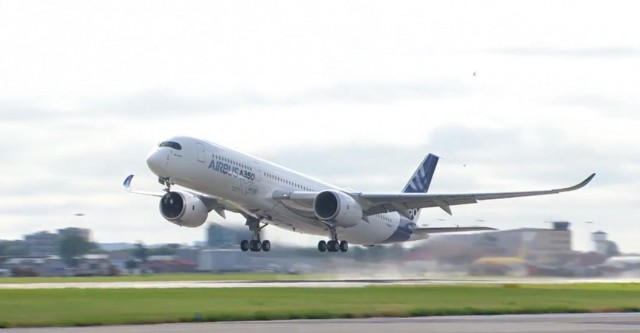
This post will be updated as new Airbus A350 events unfold. All times will be in PST, nine hours behind local time in Toulouse, France.
6/14 7:45am – We have posted the “A350 first flight” story with photos.
6/14 7:00am – Due to server issues, we were not able to update after 10:20pm, our apologies.
6/14 01:05am – Almost right on time, the first Airbus A350 took flight.
6/13 10:20pm – We made the mistake of time zones. Toulouse is in CEST, but Airbus was reporting times in UTC. Our apologizes. The live stream should start at midnight PST, the first flight is set to happen at 1am 6/14 PST. Thanks for Chris with Airchive.com (who is in Paris) for confirming.
6/13 8:00pm – Although the Airbus press release said live feed will start at 10pm PST, the live feed code above shows midnight. Trying to clarify, but we might just have to wait and see when it starts.
STORY FROM 8:50AM June 13th:
The first Airbus A350-900 XWB is scheduled to have its first flight at 10:00am UTC tomorrow, Friday June 14th. For those of you in the US, that means either an early morning (4am EST) or a late night (1am PST). But worth it? Heck yes. When is the next time we will all be able to share in the first flight of a major new aircraft? It will be quite sometime [after the Cseries].
The first flight will take place in Toulouse, France and comes just before the Paris Air Show that is scheduled for next week. Airbus plans to deliver the first A350-900 XWB in the second half of 2014 to its launch customer Qatar Airways.
Starting at 7:00am UTC (aka 1am EST and 10pm PST) Airbus will provide a live feed via their website www.A350XWBfirstflight.com. Be sure to also follow along via AirlineReporter.com, our Twitter (hashtage is #A350FF) and our Facebook page.
Want a run-down of the Airbus A350 and what it means? Check out Jack Harty’s A350 story on Airchive.com for all the background.
PREVIOUS AIRBUS A350 XWB GOODIES:
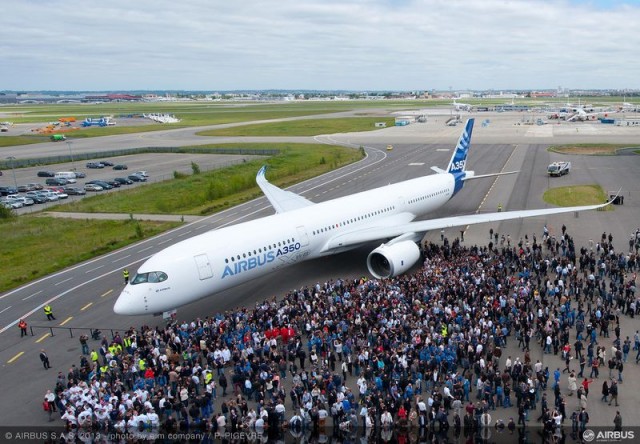
The completed A350 XWB MSN001 is welcomed by Airbus employees in Toulouse. Photo from Airbus.
The painting of the first Airbus A350 XWB was completed today in Toulouse, France. The aircraft is sporting the typcial Airbus livery that took about seven days to complete.
The aircraft, MSN001, has also completed flight-test-instrumentation (FTI) verification, engine installation and a subsequent intensive phase of ground vibration tests. Airbus is expecting MSN001 to complete its maiden flight this summer.
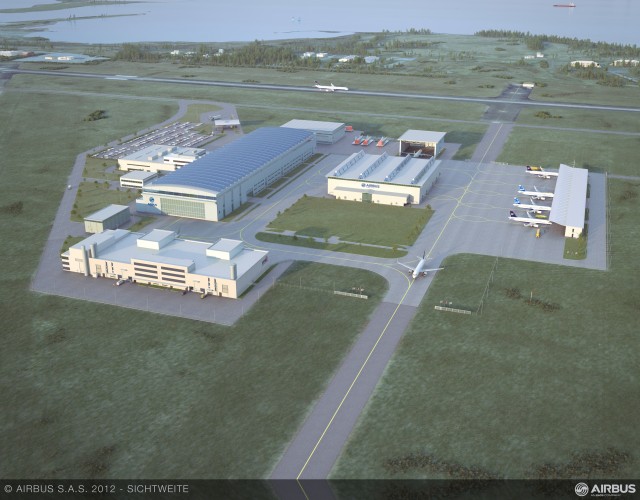
HI-RES : Click for larger. Airbus’ first U.S.-based production facility ’“ which will build A320 Family jetliners at the Brookley Aeroplex in Mobile, Alabama, beginning in 2015 ’“ will produce between 40 and 50 aircraft annually by 2018.
Last Monday Airbus took its first step towards being an around the clock aircraft maker as it broke ground on its new Mobile, Alabama A320 plant.
When we say around the clock we literally mean it, with the new Mobile factory this will be the 4thA320 factory in the world with others in China, Germany and the company’s headquarters in Toulouse France. When the A320’s begin to be built in this factory the sun will never set on the baby bus.
At the ceremony, Airbus President and CEO Fabrice Brgier acknowledged how important and significant it is for the company to open a facility in the US, ’œBuilding an A320 family assembly line in Mobile is truly groundbreaking for Airbus. Our customers need more aircraft that cut fuel burn, emissions and operating costs. With this assembly line we will be able to meet our customers’ need at their doorstep, in addition to the worldwide demand for these efficient aircraft. When the line opens, we will be the only maker to assemble aircraft in Asia, Americas and Europe.’
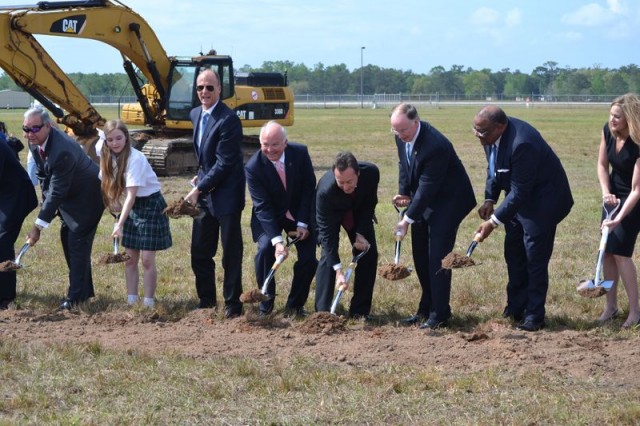
The ceremonial groundbreaking for Airbus’ U.S. A320 Family final assembly line ’“ which occurred 8 April 2013 in Mobile, Alabama ’“ was marked by Airbus President and CEO Fabrice Brgier (fourth from right) and EADS CEO Tom Enders (sixth from right), along with state and national dignitaries, industry leaders and members of the local community. Photo from Airbus.
The new line will be located at the Mobile Brookley Aeroplex and will be able to assemble the entire A320 family: the A319, A320 and A321. The airline to receive the first US built A320 will be JetBlue. “We’re excited to welcome our long-term partners at Airbus to the United States and we look forward to taking delivery of the first U.S.-produced Airbus in 2016,” JetBlue spokesperson Mateo LLeras explained to AirlineReporter.com.
BONUS: Check out the Airbus mini-site dedicated to the new Mobile location
Major construction is set to begin this summer and be complete by late 2015 with the first aircraft set to be delivered in early 2016. Once they get the dust settled and Airbus hopes that the assembly line will produce four aircraft per month. The manufacture plans to deliver aircraft from Mobile to North and South America airline customers.
So why is Airbus making this move? Well you have to go back to 2005 when Boeing was originally awarded the US Air Force (AF) Tanker contract. There were too many question surrounding fraud, that the Air Force was required to re-bid. Airbus wanted in on the contract and to make their bid serious, the aircraft maker purchased land in Mobile that it intended to open an A330 tanker factory if they won. In 2008 Airbus was awarded the contract to build the A330 Multi Role Tanker (MRT), so they went through with the purchase the land.
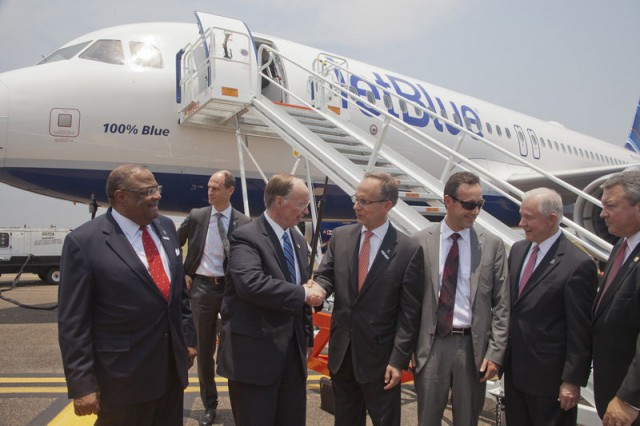
After an appeal by Boeing, the Air Force decided to re-bid for a third time where Boeing won with their 767MRT. But now Airbus had all of this land and once they learned that they lost the contract Airbus announced that it still intended to bring a couple thousand jobs to the Mobile area and create an A320 plant instead of trying to sell the land.
One question that we are all curious about at AirlineReporter.com is that by having this factory in the US now can Airbus sway major US Boeing customers to come its way such as Southwest Airlines, United Airlines or Delta Air Lines who have do already (with an exception to Southwest) have Airbuses in its fleet but only cause they acquired them through mergers with other US major airlines, not from its own purchases.
Also there is potential for Airbus to acquire more land in Mobile, could we see a second line down the road or another type come to the US all together? This could get interesting.
SEE MORE MOBILE ALABAMA AIRBUS GROUND BREAKING PHOTOS
 |
This story written by…Brandon Farris, Correspondent. Brandon is an avid aviation geek based in Seattle. He got started in Photography and Reporting back in 2010. He loves to travel where ever he has to to cover the story and try to get the best darn shot possible.@BrandonsBlog | RightStuffPhotography | Flickr |
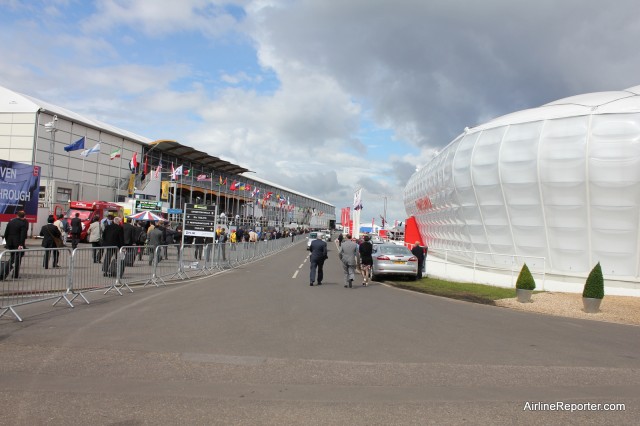
Walking into the media entrance at Farnborough 2012.
This story is unfortunately delayed, since I wrote the complete series and then lost it. So, I get to start over and hopefully I remember mostly what I originally talked about. Oh right, I flew to London and saw some planes… I think there might be a few more details than that.
I’ve been to plenty of airshows in my day, but not THE airshow. Every other year, the big airshow of the year takes turns at Farnborough (outside of London) or Paris. This year, was Farnborough’s turn and I decided it was time to take the plunge.
Monday through Friday, the airshow is only open to vendors, media and invited guests, where Saturday and Sunday is a public airshow. I was curious to check what was offered during weekday since the show is quite different over the weekend.
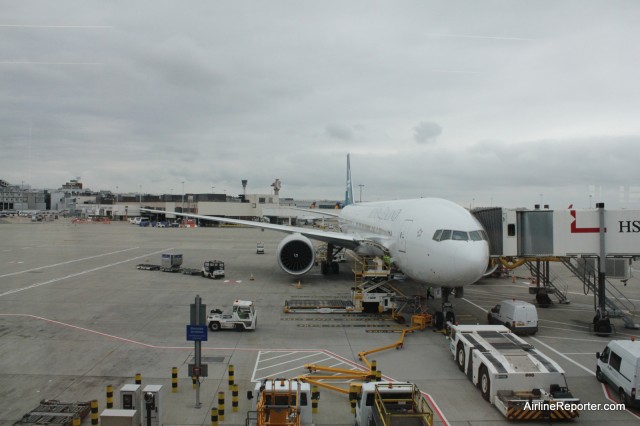
To get to London, I took Air New Zealand’s flight from LAX.
Before I did anything, I had to brave an application process for authorization to attend the show as media. After a few hurdles, I was approved and could move forward with getting my airline tickets and hotel.
While most of my international trips are planned out for me by a public relations contact; this time I was entirely on my own. First I dealt with the question: How do I get there? What airline would provide a unique journey? Air New Zealand, of course. AvGeeks know the power of riding a carrier’s uncommon route and the Air New Zealand Los Angeles (LAX) to London (LHR) takes the cake. I was set to fly their Premium Economy over to London and their Business Premiere back. Now that my flights were set, time to find my hotel.
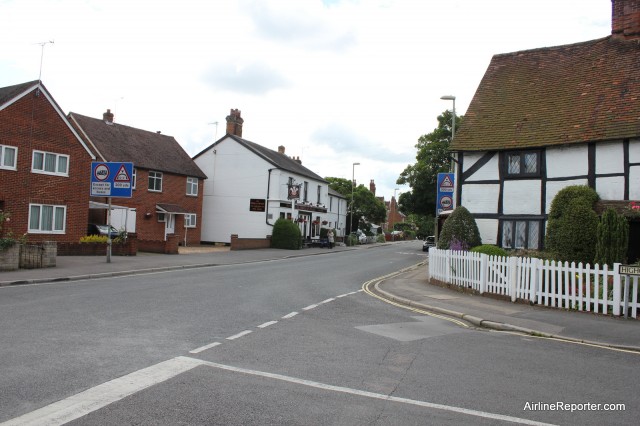
There was quite a bit of walking to get to Farnborough, but the views were too bad. This is just outside of the Farnborough North train station.
I had never been to London before and wasn’t really sure how things worked. I probably should have asked for some assistance, but decided to figure things out on my own — I kind of messed up. You see, I was late in getting my hotel room and my budget was pretty much non-existent for this trip. I knew I was probably going to have to find a place to stay outside of Farnborough and certainly not in London due to costs. I found a town less than 15 miles away from the Farnborough Airport called Bracknell and both locations had a train station. DEAL!
Here’s the problem; Bracknell is located north of Farnborough, but most of the trains run east to west, not north to south. Every morning, I would get up, walk a mile to the train station, take one train transfer, and walk another mile to another train station to catch a bus to get to the airshow. The 15 mile commute took me two and a half hours in the morning and about two hours to get back at night. Lesson surely learned.
The pain was quite worth it. Each morning my adventure would begin at the Farnborough Airport by being dropped off by a double-decker bus.
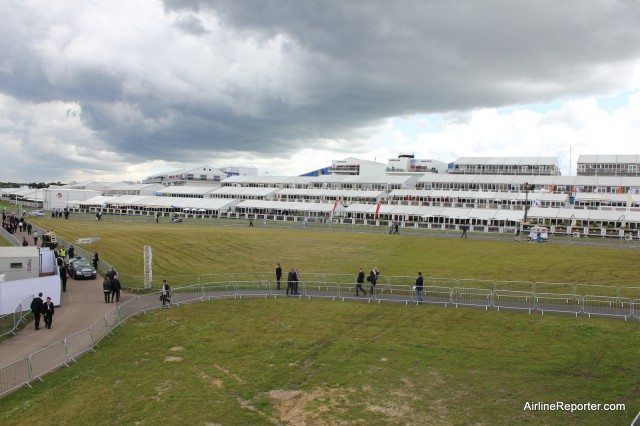
Just some of the Chalets located up the hill at Farnborough.
It’s very difficult being a single media person and knowing what the heck is going on at the airshow. First of all, there aren’t many preplanned press conferences or events and those that are, changed daily. Most days I would show up with little planned, but my schedule would become packed as the day evolved. By the last day I still wasn’t able to take a check out all the static display aircraft. It killed me, one of the primary reasons I went was to check out the planes.
The other issue was internet connection. You have about 110,000 people located in a small area, which means that cell reception was almost impossible to get. The airshow had a special media facility that offered free Wi-Fi, but it was not much better. Luckily, many other companies had their own media facilities (called chalets) and Boeing and Airbus both had free Wi-Fi that I accessed (sorry Airbus, but Boeing’s was a bit better).
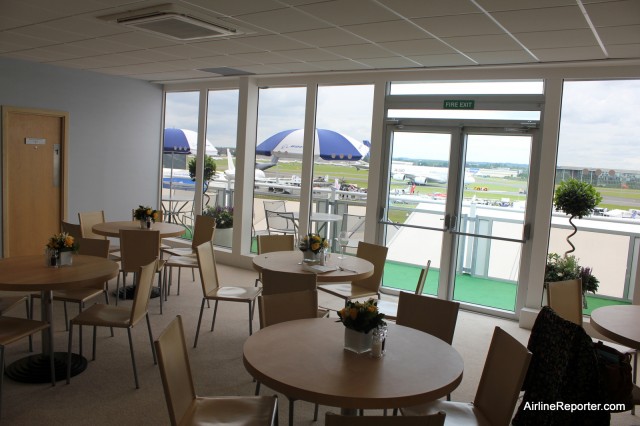
My second home while in London; Boeing’s Media Chalet at Farnborough.
Because of the internet issues, it was more likely that someone sitting at home, reading about what is going on at the airshow was more informed than a media person on-location (aka me) in a complex sea of information without solid web access. Eh, I was okay being uninformed and enjoying myself — I had no real agenda.
Larger media organizations like Aviation Week and Flight Global had huge staffs, their own chalets and obviously quite a few resources to cover the airshow from top to bottom. I went to the airshow without any real game plans except hoping to get on the Malaysian Airbus A380, the Qatar Airways 787, see as many airplanes, meet new people and have fun — mission accomplished.
In PART 2, I will talk in more detail about what it was like being at the airshow and what I hope to have accomplished next year (if I am able to go). Until then, enjoy the photos…

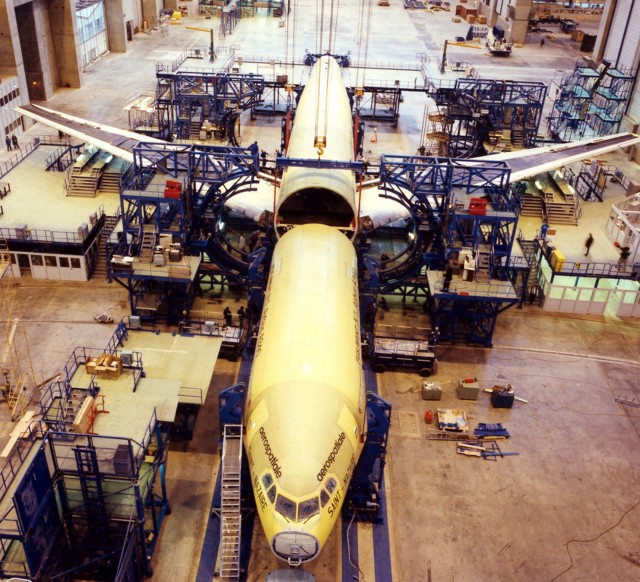
The very first Airbus A340 takes shape inside their factory. Photo from Airbus.
I have always loved the look of the Airbus A340. In the early days of jet airlines, seeing a single-deck plane with four engines on the wing was common. By the time the A340 first flew on October 25, 1991, there weren’t too many Boeing 707s or Douglas DC-8s flying around. Even for the amateur aviation enthusiast, it has always been quite easy to spot an A340.
The engines might provide an easy tell on what kind of aircraft it was, but they also drained a lot of fuel. Airlines started to opt for two engine Airbus A330s and Boeing 777s instead of the A340. Due to a lack of demand, Airbus officially announced the end to the aircraft due to a, “changing market dynamic,” (aka no orders) on November 10, 2011.
Although Airbus is no longer making the A340, there are still four that are left to be delivered. Two are set to go to VIP customers and two were ordered by Kingfisher Airlines. It is not certain when the final four will be delivered, but I am going to bet that Kingfisher might never take delivery of their two A340s due to their current financial difficulties.
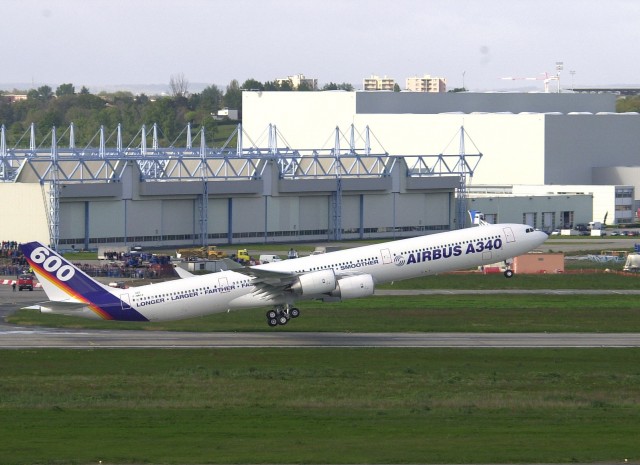
The first Airbus A340-600 takes off in Airbus livery. Photo from Airbus.
Well, times have changed with ETOPS certification and today, two engine aircraft can fly much farther away from land than they used to. When the A340 was first produced, many passengers (and probably even airlines) were weary of flying over water with two engines and the Boeing 777 wasn’t even in production.
As Boeing Randy Tinseth points out in his blog, Airbus used creative advertising to possibly play off the fears of passengers who might not want to fly over the open seas using a two-engined aircraft. Obviously any fear that people might have had was put to rest with the success of many airliners who have successfully flown over open waters with only two engines.
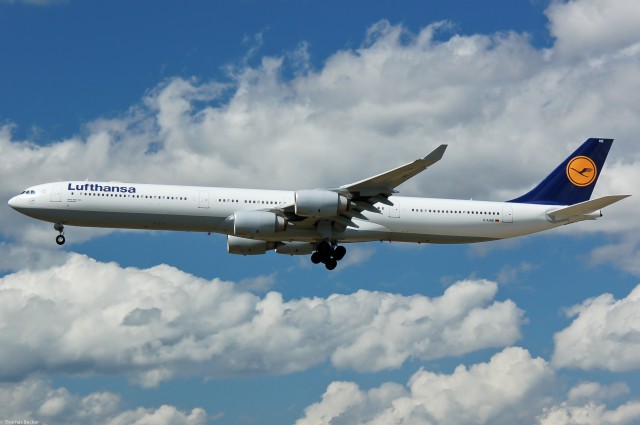
Lufthansa Airbus A340-642 D-AIHE Leverkusen. Photo by Thomas Becker.
There were a total of 379 of the A340 ordered and 365 are still in service today. Lufthansa Airlines is the largest operator of the A340 with 51 currently in service.
“Technological achievements during the last years today allow to operate aircraft of the size of the A340-300 efficiently with two engines, what hasn’t been the case earlier,” Nico Buchholz, Head of Lufthansa Group Fleet Management explained to AirlineReporter.com. “Still, on some routes the A340-300 is still superior to it’s twin-engine competitors, with regards to payload and flight performance. In light of the huge accomplishments made, however, aircraft of this segment now and in the future are clearly twin-engines, as demonstrated impressively by B777, A330, B787 and A350 aircraft.”
Currently, Lufthansa is not planning to replace any of their A340 fleet anytime soon. “We keep on applying modifications to make them more fuel-efficient, reduce noise or make cockpit modifications,” Buchholz explained. “That being said, our fleet is economically and technically up to date and we have no huge pressure to make a buying decision here. We will decide at an appropriate time.”
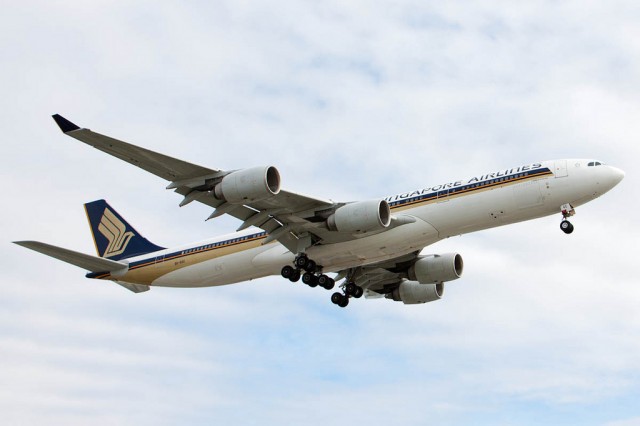
Singapore Airlines Airbus A340-500 landing at LAX. Photo by Bob Connolley
Singapore Airlines only operates five of the A340 aircraft, but they are unique in using them to fly the world’s two longest flights: Los Angeles (LAX) and Newark (EWR) to Singapore (SIN). Flight SQ21, from EWR to SIN, is the longest scheduled airline flight in the world, which is 9,535 miles and takes almost 19 hours. Flight SQ 37, from LAX to SIN, is the world’s second longest flight at 8,770 miles and takes about 18 hours. Both of these flights exclusively use the Airbus A340-500 aircraft. “What the aircraft does is create a non-stop link between the US and Singapore for growth,” James Boyd, Singapore Airline’s Vice President of Communications for the Americas explained to AirlineReporter.com.
At the time that Singapore Airlines started the flights, the A340-500 was the only aircraft capable of operating routes that long. Even today, there are only two aircraft that are able to handle the route: the A340-500 and Boeing 777-200LR.
Even though Singapore Airlines also operates the 777, Boyd explained that they are not planning on replacing their A340-500s anytime soon. Recently the airline invested quite a bit of money updating all five cabins on their A340s to all Business Class, providing the same product that is found on their Airbus A380.
Singapore Airlines is unique due to operating aircraft that many see as directly competing against each other: the Boeing 777 and Airbus A340/A330, the Boeing 747 and Airbus A380, and they have the Boeing 787 and Airbus A350 on order. Why? Because many of their routes are market and destination specific and each route is specifically matched up to the aircraft it uses and for them, that means a diverse fleet. Singapore’s two routes that use the A340-500s are very profitable and it wouldn’t make any sense to change out aircraft.
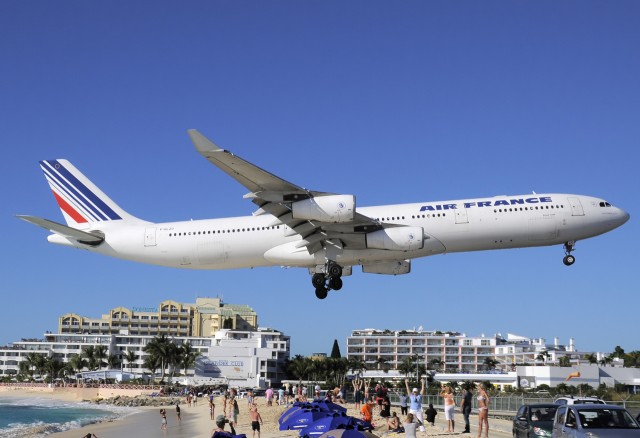
Air France Airbus A340-300 landing at the iconic Saint Maarten. Photo by Jordi Grife..
The end of the Airbus A340 leaves only two quad jets that remain in commercial airliner production: The Boeing 747-8 Intercontinental and the Airbus A380. As engines become more efficient, will there be more quad jets into the future? Probably not, but for those of us that get a kick out of seeing jets with more than two engines, at least we will see the A340 still flying for quite some time to come.
Images:
Lufthansa A340 – Thomas Becker
Singapore A340 – Bob Connolly
Air France A340 – Jordi Grife

















